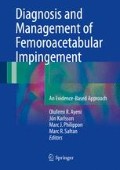Abstract
Early degenerative hip disease has often been noted in patients with abnormal acetabular morphology usually secondary to developmental dysplasia of the hip (DDH), and it has been hypothesized to be the consequence of abnormal edge loading on the anterosuperior acetabular cartilage from an eccentrically centered femoral head. However, the role femur morphology played in the development of degenerative hip disease was not as defined. In 1936, Smith-Petersen classically described a concept of impingement in which hip pain was theorized to be caused the femoral neck impinged against anterior acetabular margin [1]. Surgical correction, by way of impingement correction, was successful in his small case series. Decades later, Murray et al. described a tilt deformity of the proximal femur and its association with the development of osteoarthritis of the hip [2]. In 1986, Harris described his theory on how derangements in femoral anatomy development caused primary or “idiopathic osteoarthrosis of the hip” in the non-dysplastic hip [3]. Harris wrote that based on his numerous radiographic observations, the convex, “pistol grip” femoral deformity at the femoral head-neck junction following the sequelae of a recognized or undetected slipped capital femoral epiphysis (SCFE), Legg-Calve-Perthes disease, or the congenital epiphyseal dysplasia was a common pathway for development of the so-called “idiopathic” degenerative hip disease. Although Harris reported of the association of abnormal femoral head-neck deformity and osteoarthritis, he did not elaborate on the underlying mechanisms that such deformity can result in the development of primary degenerative hip disease.
Access this chapter
Tax calculation will be finalised at checkout
Purchases are for personal use only
References
Smith-Petersen MN. Treatment of malum coxaesenilis, old slipped upper capital femoral epiphysis, intrapelvic protrusion of the acetabulum, and coxae plana by means of acetabuloplasty. J Bone Joint Surg Am. 1936;18:869–80.
Murray RO. The aetiology of primary osteoarthritis of the hip. Br J Radiol. 1965;38(455):810–2.
Harris WH. Etiology of osteoarthritis of the hip. Clin Orthop Relat Res. 1986;213:20–33.
Harris WH, Bourne RB, Oh I. Intra-articular acetabular labrum: a possible etiological factor in certain cases of osteoarthritis of the hip. J Bone Joint Surg Am. 1979;61(4):510–4.
McCarthy JC, Noble PC, Schuck MR, Wright J, Lee J. The Otto E. Aufranc Award: the role of labral lesions to development of early degenerative hip disease. Clin Orthop Relat Res. 2001;393:25–37.
McCarthy JC, Noble PC, Schuck MR, Wright J, Lee J. The watershed labral lesion: its relationship to early arthritis of the hip. J Arthroplasty. 2001;16(8 Suppl 1):81–7.
Ferguson SJ, Bryant JT, Ganz R, Ito K. The influence of the acetabular labrum on hip joint cartilage consolidation: a poroelastic finite element model. J Biomech. 2000;33(8):953–60.
Ferguson SJ, Bryant JT, Ganz R, Ito K. The acetabular labrum seal: a poroelastic finite element model. Clin Biomech (Bristol, Avon). 2000;15(6):463–8.
Ferguson SJ, Bryant JT, Ganz R, Ito K. An in vitro investigation of the acetabular labral seal in hip joint mechanics. J Biomech. 2003;36(2):171–8.
Cadet ER, Chan AK, Vorys GC, Gardner T, Yin B. Investigation of the preservation of the fluid seal effect in the repaired, partially resected, and reconstructed acetabular labrum in a cadaveric hip model. Am J Sports Med. 2012;40(10):2218–23.
Ganz R, Parvizi J, Beck M, Leunig M, Nötzli H, Siebenrock KA. Femoroacetabular impingement: a cause for osteoarthritis of the hip. Clin Orthop Relat Res. 2003;417:112–20.
Lavigne M, Parvizi J, Beck M, Siebenrock KA, Ganz R, Leunig M. Anterior femoroacetabular impingement: part I. Techniques of joint preserving surgery. Clin Orthop Relat Res. 2004;418:61–6.
Ganz R, Gill TJ, Gautier E, Ganz K, Krügel N, Berlemann U. Surgical dislocation of the adult hip a technique with full access to the femoral head and acetabulum without the risk of avascular necrosis. J Bone Joint Surg Br. 2001;83(8):1119–24.
Larson CM, Giveans MR. Arthroscopic debridement versus refixation of the acetabular labrum associated with femoroacetabular impingement. Arthroscopy. 2009;25(4):369–76.
Philippon MJ, Briggs KK, Hay CJ, Kuppersmith DA, Dewing CB, Huang MJ. Arthroscopic labral reconstruction in the hip using iliotibial band autograft: technique and early outcomes. Arthroscopy. 2010;26(6):750–6.
Murphy KP, Ross AE, Javernick MA, Lehman RA Jr. Repair of the adult acetabular labrum. Arthroscopy. 2006;22(5):567.e1–3.
Philippon MJ, Weiss DR, Kuppersmith DA, Briggs KK, Hay CJ. Arthroscopic labral repair and treatment of femoroacetabular impingement in professional hockey players. Am J Sports Med. 2010;38(1):99–104.
Sierra RJ, Trousdale RT. Labral reconstruction using the ligamentum teres capitis: report of a new technique. Clin Orthop Relat Res. 2009;467(3):753–9.
Beck M, Leunig M, Parvizi J, Boutier V, Wyss D, Ganz R. Anterior femoroacetabular impingement: part II. Midterm results of surgical treatment. Clin Orthop Relat Res. 2004;418:67–73.
Bedi A, Chen N, Robertson W, Kelly BT. The management of labral tears and femoroacetabular impingement of the hip in the young, active patient. Arthroscopy. 2008;24(10):1135–45.
Philippon MJ, Briggs KK, Yen YM, Kuppersmith DA. Outcomes following hip arthroscopy for femoroacetabular impingement with associated chondrolabral dysfunction: minimum two-year follow-up. J Bone Joint Surg Br. 2009;91(1):16–23.
Philippon MJ, Stubbs AJ, Schenker ML, Maxwell RB, Ganz R, Leunig M. Arthroscopic management of femoroacetabular impingement: osteoplasty technique and literature review. Am J Sports Med. 2007;35(9):1571–80.
Author information
Authors and Affiliations
Corresponding author
Editor information
Editors and Affiliations
Rights and permissions
Copyright information
© 2017 Springer International Publishing Switzerland
About this chapter
Cite this chapter
Cadet, E.R. (2017). Historical Background of the Treatment of Femoroacetabular Impingement. In: Ayeni, O., Karlsson, J., Philippon, M., Safran, M. (eds) Diagnosis and Management of Femoroacetabular Impingement. Springer, Cham. https://doi.org/10.1007/978-3-319-32000-7_1
Download citation
DOI: https://doi.org/10.1007/978-3-319-32000-7_1
Published:
Publisher Name: Springer, Cham
Print ISBN: 978-3-319-31998-8
Online ISBN: 978-3-319-32000-7
eBook Packages: MedicineMedicine (R0)

